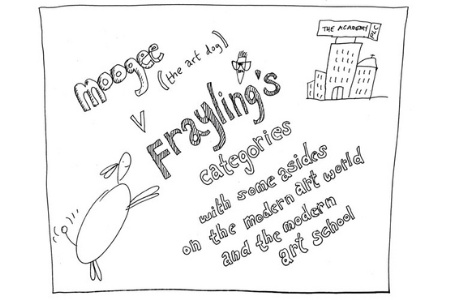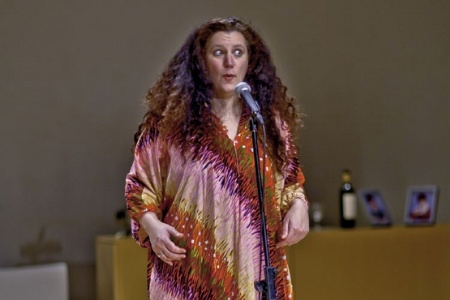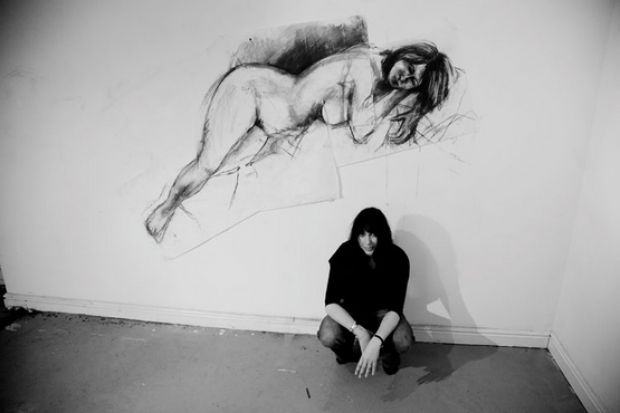Tensions in practice as research as performance have arisen: whether there is a need for it to be commercially viable or even particularly ‘good’ as performance
When Roberta Mock became Plymouth University’s first professor of performance studies, she decided to give an inaugural lecture that demonstrated, rather than just described, what her work is all about.
The event unfolded in three stages. The first was a reception with wine, snacks and a birthday cake. Mock herself did not attend, but a colleague relayed a welcome speech from her mother describing her precociousness, her toilet training and other intimate details of her childhood.
The audience was then ushered into the main hall, where the stage was decorated as a living room in suburban Detroit in 1985. Mock, dressed as an elf, delivered a monologue in the persona of Bobby, a Jewish housewife who had become a minor local celebrity through appearing year after year in television advertisements as the Tel-Twelve Mall Elf.
Although it is her birthday and Bobby is trying to be cheerful, misery keeps breaking through. “Every girl needs a gay best friend when her marriage screws up,” she told the audience. “Really, it makes all the difference. And his boyfriend Bob has been so good about it - you know, me phoning in the middle of the night and crying and everything. That’s all over now, of course - got it all out of my system ages ago. I don’t care at all that Mel is in Aruba with his new lady friend.”
The third stage of the evening came when Bobby thanked her guests, the dean gave a formal introduction to Mock’s lecture - and she re-emerged in what she describes as “an awful polyester kaftan” singing an adapted version of the Petula Clark hit Downtown.
“I can sense a little frisson in the air,” she told those gathered. “You were expecting me, perhaps, to stop performing. At least so explicitly. To be myself. I promise you that I am - and have been from the moment I stepped out on stage.
“I am no longer being Bobby, the suburban housewife who was once and always the Tel-Twelve Mall Elf on Detroit television - Bobby, who was just celebrating her birthday, with you, in 1985. I am Roberta Mock, and I am here coincidentally celebrating my birthday here with you in 2011.”
And with that she removed the kaftan - briefly causing the audience to wonder what she was wearing underneath, as she had been “told never to use any nudity in a university lecture” - and proceeded to the lectern (still clothed) to deliver a reasonably traditional lecture on the themes of her performance so far.
“Sometimes cities that seem most alive are cities that are dying - angrily,” Mock explained. “Detroit was exhilarating when I played there with my friends in the mid-1980s; it was seething, cracking and shooting itself up.” She had also come to realise, she continued, that “Bobby is the me I was afraid I would become in 1985, the year I left North America”.
All this sounds a good deal more entertaining than the average specialist inaugural lecture that people feel obliged to attend out of solidarity with colleagues. Like any interesting piece of performance, it must have resonated with others in the audience, prompting them to reflect on their own experiences of growing up in edgy cities or being shaped by the ephemeral popular culture of their youth.
Yet Mock is adamant that her strikingly unusual inaugural “wasn’t just performance. The slippage between registers and voices was precisely what I wanted to show. It gave me a platform for reaching the people I wanted to reach, telling the academic community who have sat in committees with me at Plymouth for 20 years: this is research, this is what I do - deal with it!”
Even now, it is safe to say, this counts as the wilder shores of research. Yet it also raises broader issues about how different kinds of artistic practice have become part of the research carried out in universities, leading to a blurring of “the bounds between the creative and the academic”.

The distinction between the work I make as pure research and my practice as an artist has blurred. The relationship…is no longer simply a bureaucratic convenience
It starts at PhD level. Amanda Roberts is an artist who has long loved life drawing and often produces huge female nudes in charcoal - she calls one recent work Attack of the 10ft Pregnant Woman. Yet she is also very aware of “the body of feminist theory from the 1970s” that argues that “by representing the female nude figuratively, the voyeuristic gaze is inevitable - you can’t avoid the female body being objectified and sexualised by the male gaze. As a practitioner working with the female nude, that’s quite problematic for me.”
During her master’s, Roberts tried to make her work “compatible” with feminist theory, which meant moving away from figurative painting and drawing. For her ongoing PhD at Swansea Metropolitan University, however, “figurative work is the constant, so how can I negotiate this body of feminist critique in my work as a woman painter?”
The only way to explore this practical, emotional and intellectual dilemma in a PhD is through an “argument” that interweaves artworks and analysis. So Roberts has adopted what she calls “a cyclical process: do the work, look at and evaluate what you’ve done, go back and do some more work”.
While actually painting, she explains, she “doesn’t give a stuff about [feminist theorists such as] Laura Mulvey. You can’t let the theory direct the work in that way…You don’t want your artwork just to illustrate the theory, because then you don’t need it.”
Rather, Roberts continues, her artwork generates the questions for analysis - “I wouldn’t know what questions to ask otherwise.” Even if a drawing or painting ends up being quite uninteresting to look at, provided “it gives you the findings you need, within a PhD it counts as a successful piece of work”.
Both Mock’s and Roberts’ projects are signs of a significant change that has taken place in higher education over the past 15 or 20 years. At least from the time of the 1996 research assessment exercise, as Nicholas Till argues, arts colleges have set out “a vigorous case for the creative work of artistic practitioners teaching in higher education institutions to be considered as research for the purpose of the RAE”. There has also been widespread acceptance of PhDs that combine a significant element of “practice” with an extended text-based dissertation.
Yet it has not all been plain sailing. Debate has raged about whether we should be talking about “practice as research”, “practice-based research”, “practice-led research” or even (in parallel with historical or psychological research) just “artistic research”. Sir Christopher Frayling, rector of the Royal College of Art from 1996 to 2009 (and now a fellow of Churchill College, Cambridge), laid down in 1993 a celebrated distinction between “research into art and design, research through art and design and research for art and design”. Shaun Belcher, senior lecturer in multimedia at Nottingham Trent University, is working on a series of cartoons in which a character called Moogee the Art Dog investigates how these different categories have been debated and challenged.
There are other disputes about the challenges of assessing hybrid PhDs and whether the aesthetic merits of the “practice” submitted should or should not be taken into account.
Mock points to “tensions in practice as research as performance that have arisen over the past couple of years: whether there is a need for it to be commercially viable or even particularly ‘good’ as performance, because we have now trained a generation who have come through a BA and an MA and have then gone into PhDs with a level of practice which has never been tested in the outside world. All performance-making involves at some level communication with other people, so there is a basic skill needed.” (Comedy might seem to be a particularly clear example of this, although Mock remembers one PhD student who was developing “a kind of radical feminist clowning practice that didn’t revolve around laughter. She had no problem that no one was laughing during her tutorials.”)
Some of the broader issues raised by the trend towards practice as research are explored by Till in the article that follows. The case in favour is put by Malcolm Quinn, associate dean of research at the University of the Arts London.
Despite acknowledging that “you could have a fully functioning art world without PhDs”, he believes such degrees offer artists and designers “the opportunity to pursue research issues in depth that might be latent in their practice but not followed up - the PhD research cycle (three to five years) gets people off the carousel of gallery shows or commercial briefs”.
For artists working within universities, research tends to be part of their contract of employment. Quinn sees no problem with their engaging with research councils and their agendas, which inevitably have a political dimension, and he is not concerned that this engagement may undermine some of art’s subversive power. Those who want to and can afford it can always opt out and pursue the path of painters such as Lucian Freud, who kept away from the academy and “didn’t even attend his own private views”.

More generally, Quinn stresses a national dimension to the training of artists.
In Germany, he explains, “there is an apprenticeship system where you enter the studio of the master. The American master of fine arts [degree] is very much about the artist in the spotlight, dominated by the gallery system, and research is not considered important. The British system offers an opportunity to think through what it means to be an artist in the university. Rather than still debating what research is, we have come to accept it as a possible dimension for artists and designers, and essential for those working in the academy. The benefits are clearer.”
Many artists, often to their surprise, have found the research agenda highly congenial.
As he looks back to the 1990s, “when the notion of studio-based research taking place in universities was first born”, Quinn’s colleague Stephen Farthing - the Rootstein Hopkins chair of drawing at the University of the Arts London - “saw the work I did as an artist as being very different from the work I did, for example, with a plastic surgeon on a sci-art project for the Wellcome Trust. At that time as an artist I was interested in an area I can best describe as ‘modernist history painting’; as a ‘researcher’ I was working with digital imaging and a surgeon in a bid to better understand the nature of normal appearance.”
Yet, strangely enough, it was the latter that led the National Portrait Gallery to commission a group portrait from him, the first portrait commission Farthing had ever received, so a research project that was independent of his studio work “ended up giving back to my work as a painter”. More generally, he believes that “over the past 10 years the distinction between the work I make as pure research and my practice as an artist has progressively and, I think, positively blurred…the relationship between universities and artists, research assessment and creativity, is no longer simply a bureaucratic convenience”.
A similar story is told by Louise Tondeur, senior lecturer in creative writing at the University of Roehampton, who studied for the celebrated MA in creative writing at the University of East Anglia. She then wrote two novels, The Water’s Edge and The Haven Home for Delinquent Girls, for a mainstream publisher before embarking on a PhD. She has now published academic research on queer theory, skin, body hair and the Pre-Raphaelite artist, model and poet Elizabeth Siddal.
Although they certainly incorporated and communicated information about the women’s history she was exploring, she notes, she “didn’t think of the novels as research when I was writing them, because I was not then in an academic context. Writers and artists outside academia don’t have to define themselves in the same way as those working within it.” She now hopes to contribute both stories and essays to the research excellence framework.
Far from seeing an academic environment as a constraint on her creativity, Tondeur feels more constrained by publishers’ demand for material that is “very plot-driven”.
“I would like to blur the bounds between the creative and the academic,” she adds. “When I did my MA at UEA, it provided structure and time for writing, and I have now found that again in a similar environment. My immediate colleagues are writers and I have benefited from the presence of other writers in the academy, since I work day to day with them and we talk about practice. My work has got better because of that, not because I have got highly theoretical about it.”
Tondeur admits that she would “once have been suspicious of what I have just said. Some novelists reject intellectualising about the writing process, but may later find that they need to reflect on their working methods - I certainly did.”
Just how radical a shift this represents is made clear by the description of a two-day conference that Tondeur is organising, Practice, Process and Paradox: Creativity and the Academy, which will be held in April at ReWrite, Roehampton’s Centre for Research in Creative and Professional Writing.
“Practising a particular creative art is a kind of academic research,” we read. This is surely rather startling. Many of the leading dancers, painters and writers of the past never even saw the inside of a university, and most rappers, musicians and stand-up comics presumably do not see themselves as engaged in any “kind of academic research”. By embracing practice as research, universities have expanded and extended many traditional notions of research. They are also challenging many common assumptions about artistic practice.
Register to continue
Why register?
- Registration is free and only takes a moment
- Once registered, you can read 3 articles a month
- Sign up for our newsletter
Subscribe
Or subscribe for unlimited access to:
- Unlimited access to news, views, insights & reviews
- Digital editions
- Digital access to THE’s university and college rankings analysis
Already registered or a current subscriber? Login




